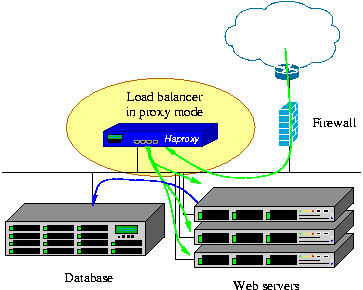HAProxy
Free, very fast and reliable solution for :
- HA (High Availability)
- Load balancing - suited for very high traffic web sites
- Proxying
It can load balance any TCP service, particularly suited for HTTP as it supports session persistence and layer 7 processing.
Usage
- De-facto standard
- Open source
- Shipped with most mainstream Linux distributions
- Often deployed by default in cloud platforms

HAProxy is :
- TCP Proxy
- Accept a TCP connection from a listening socket, connect to a server.
- Allows traffic in both directions
- HTTP RP
- Also called Gateway
- As a server, receives HTTP requests and passes the requests to servers
- Server load balancer
It can load balance TCP connections and HTTP requests - TCP mode : Load balancing decisions are taken for the whole connection.
- HTTP mode : Decisions are taken per request.
- Content-based switch
- Any element from the request can decide what server to pass the request or connection to.
- Makes possible to handle multiple protocols over a same port (eg: http, https, ssh)
- SSL terminator / initiator / offloader
- SSL/TLS may be used on the connection coming from the client / to the server / both side
- TCP normalizer
- Protects abnormal traffic - invalid packets, flag combinations, window advertisements, sequence numbers,
incomplete connections (SYN floods)
- HTTP normalizer
- When configured to process HTTP traffic, only valid complete requests are passed.
- protects against a lot of protocol-based attacks
- HTTP fixing tool
- can modify / fix / add / remove / rewrite the URL or any request or response header
- helps fixing interoperability issues in complex environments
- Traffic regulator
- can apply some thresholds, which protects the servers against overloading
- adjust traffic priorities based on the contents
- A protection against DDoS and service abuse
- Detect when an abuse is happening, then take action (slow down the offenders, block them, send them to outdated contents, etc).
- HTTP compression offloader
- It can compress responses which were not compressed by the server, thus reducing the page load time for clients with poor connectivity or using high-latency, mobile networks.
- Explicit HTTP proxy
proxy that browsers use to reach the internet. Like, Squid
- Caching proxy
returns as-is the contents its received from the server. Like, Varnish
- Data scrubber
It will not modify the body of requests nor responses.
- Web server
During startup, it isolates itself inside a chroot jail and drops its privileges, so that it will not perform any single file-system access once started.
So, it cannot be turned into a web server. Like, Apache or Nginx
- Packet-based LB
It will not see IP packets nor UDP datagrams and will not perform NAT or even less DSR. Like, IPVS (Linux Virtual Server)

No comments:
Post a Comment
Note: only a member of this blog may post a comment.